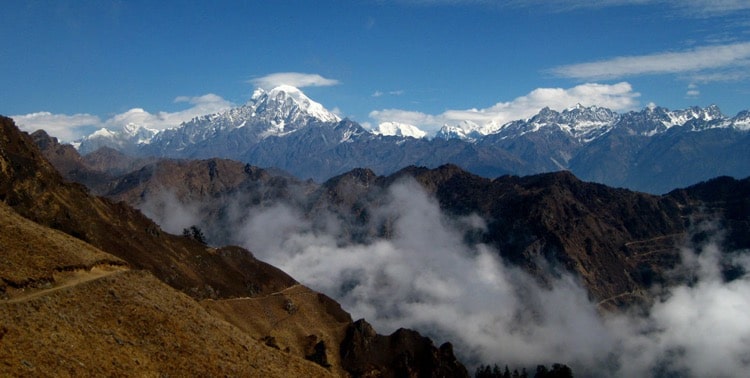Three Pass Three Kunda Ruby Valley Trek
Request a Quote (?)
- Satisfied Client
- Personalised Guide
- Instant Response
Get Instant Response:
+977-9851329446 (Whatsapp)
| Starts at: Bhalche Gaon | Ends at: Salangkot |
| Trek Region: Ganesh Himal | Transport: Public bus |
| Duration: 16 days | Trip Grade: Moderate |
| Max Altitude: 4050 m/ 13287 ft (Sing La Pass) | Accommodation: Tent |
The Ganesh Himal region is in central Nepal, located between Langtang National Park and the Manaslu Conservation Area.
The Three Pass Three Kunda Ruby Valley Trek involves hiking over three passes, namely Sing La (4,050 m), Pang Sang (3,850 m), and Magne Goth (2,950 m).
It also takes in three religious Kunda or lakes, namely Kalo Kunda, Seto Kunda, and Ganesh Kunda. The twin waterfalls of Ganga and Jamuna are also seen on this trek.
The passes themselves are not very high as passes in the Himalayas go! Sing La and Pang Sang are traversed on the same day. The views from the passes include Langtang, Ganesh Himal, and Manaslu ranges, with just a touch of the Annapurna.
The final pass, Magne Goth leads, the following day, to Ganga and Jamuna. It is interesting that these names belong to Hindu twin goddesses and are usually given to twin girls (twins not being very usual in Nepal).
Thousands of devotees make a pilgrimage to the temple here, particularly on the Purnima and Makar Sakranti festivals. Devotees believe your desires will be fulfilled if you visit this temple.
Blessed with geographical, cultural, and biological diversity, in this area, there are not only hundreds of species of precious medicinal herbs but also rubies and crystals!
Around Hindung village is an area where crystals and rubies are mined, while in the surrounding highlands yarsagumba is harvested. Yarsagumba is a unique caterpillar-fungus fusion that occurs when parasitic mushroom spores infect and mummify a ghost moth larva living in the soil. A spindly fungus later sprouts from the dead caterpillar host’s head.
It is sought after, particularly in Tibet, as an aphrodisiac. Rubies are also mined around the area of the Kalo and Seto lakes, which are also thought to have mystical powers – being able to either bless or punish visitors. At the holy lake of Ganesh Kunda, shamans gather in large numbers during September.
This 16 days trek has a bit of everything from crossing Himalayan passes with stunning mountain views; learning about the culture and traditions, both Hindu and Buddhist of the surrounding area, and visiting magical lakes and waterfalls. It is a paradise for those who want to see the alternative trekking region of Nepal.
Three Pass Three Kunda Ruby Valley Itinerary
Day 1: Kathmandu to Bhalche Gaon (Drive)
Bhalche Gaon – 1850 m / 6069 ft – 6 hrs
Day 2: Bhalche Gaon to Rupchet
Rupchet – 3250 m / 10662 ft – 6 hrs
Day 3: Rupchet to Pang Sang Pass via Singla Pass
Pang Sang Pass – 3842 m / 12604 ft – 7 hrs
Day 4: Pang Sang Pass to Chalish
Chalish – 1875 m / 6151 ft – 6 hrs
Day 5: Chalish to Hindung
Hindung – 2402 m / 7880 – 5 hrs
Day 6: Hindung to Thulo Dhunga
Thulo Dhunga – 3337 m / 10948 ft – 5 hrs
Day 7: Thulo Dhunga to Base Camp
Base Camp – 3691 m / 12109 ft – 6 hrs
Day 8: Explore Base Camp
Base Camp – 3691 m / 12109 ft – 3 hrs
Day 9: Base Camp to Kharka
Kharka – 3900 m / 12795 ft – 5 hrs
Day 10: Kharka to Ganesh Kunda
Ganesh Kunda – 3500 m / 11482 ft – 5 hrs
Day 11: Ganesh Kunda to Tatopani
Tatopani – 1250 m / 4101 – 6 hrs
Day 12: Tatopani to Lapa Gaon
Lapa Gaon – 1850 m / 6069 ft – 5 hrs
Day 13: Lapa Gaon to Magne Goth Pass
Magne Goth Pass – 2950 m / 9678 ft – 4 hrs
Day 14: Magne Goth Pass to Tinsure
Tinsure – 1850 m / 6069 ft – 6 hrs
Day 15: Tinsure to Salangkot
Salangkot – 1250 m / 4101 ft – 5 hrs
Day 16: Salangkot to Kathmandu (Drive)
Kathmandu – 1300 m / 4265 ft – 7 hrs
Not satisfied with this Itinerary?
Are you interested on planning custom trip? It only takes 2 minutes.
Includes
- 16 nights accommodation in tents
- Guide for 16 days
- Cook for 16 days
- Required number of porters for 16 days
- Kathmandu Bhalche Gaon local bus
- Salangkot Kathmandu local bus
- Langtang national park entry permit
- Trekker information management system card
- 16 x breakfast, 15 x lunch and 15 x dinner while on trek
- Private Jeep USD 360 (Optional)
- Accommodation and meals in Kathmandu
Three Pass Three Kunda Ruby Valley Trek Map

